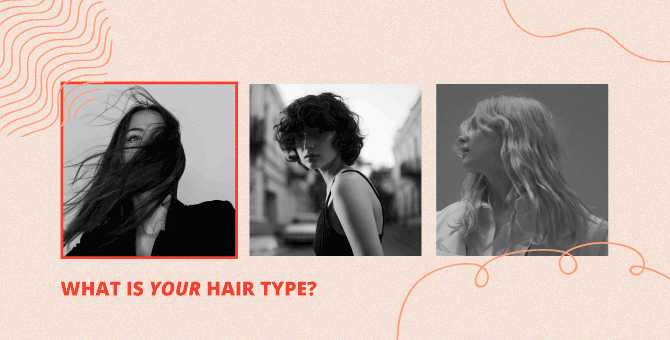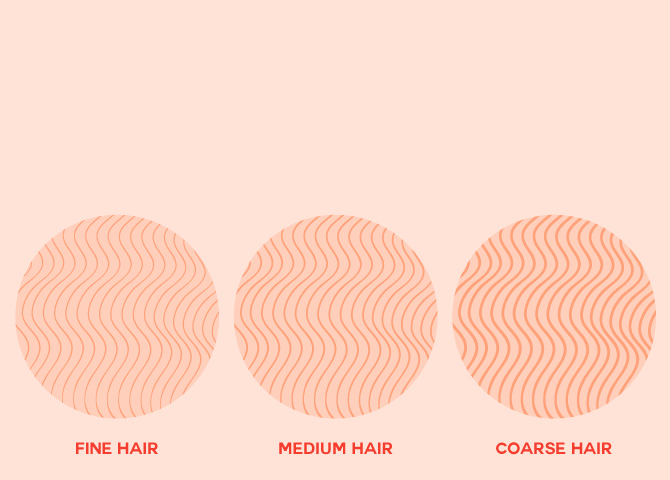Your guide to hair types and how to get your best hair yet
Just my type

Newsflash: You may have the perfect hair routine… for the wrong head of hair. Read on to find out what your actual hair type is and get your best hair yet.
When it comes to hair care, even the most expensive creams and potions won’t do much if they’re wrong for your hair type. Hair comes in all shapes and textures—maybe you’ve got a head of straight, silky locks that tend to fall a little flat. Or, perhaps you’ve got wild, bouncy curls with a hefty side of frizz. Maybe you’ve got something in between that just won’t behave, or maybe it’s bad hair care habits.
You see, the wrong hair routine can completely change your texture—loose, curly ringlets can become fried, straight frizz without the right conditioner. Straight, voluptuous hair can go limp at the root with too-heavy formulas. It’s all about narrowing your hair care routine down to what works for you, specifically, be it a ten-step extravaganza or a two-step quickie.
But what if you’re not sure what your hair type is in the first place? Well, lucky for you, we’ve compiled a little guide to help you out on that front.
Five things to look out for:

In short, this step helps you determine whether your hair is coarse or fine. It’s got nothing to do with how much hair you have (that comes next) but has everything to do with how wide the individual strands are.
To determine this is easy—just take a good look at your hair. Place a single strand next to a piece of sewing thread for comparison. If your hair strand is thicker than the thread, it’s likely your hair is coarse and potentially more difficult to style. If it’s thinner, then it’s likely that your hair is fine, and is likely to struggle with holding styles. If, however, it looks like it matches the thread in width, you’ve got medium-thick hair which tends to cope well with any and all styling.

Now, this is the part that tells you how much hair you have. To find out, take a section from the front of your hair, and pull it down to the side to part your hair. Now, you’ll want to judge how much of your scalp you can actually see—if it’s clearly visible, then you have thin hair. If not, you have thick hair. If you’re somewhere in between, then you’ve got yourself some medium-density hair.
Now, this is a useful indicator in determining the health of your scalp. For example, if you’ve gradually gone from thick hair to thin hair over time, it could be an indication of hair loss. That sounds scary, but hair loss isn’t always an indication of worrying hereditary conditions—it may just be down to product buildup, which can be remedied with a little product switch-up (or scalp exfoliant).

This basically describes how well your hair can absorb product (or moisture): hair with high porosity readily takes up moisture and product, while hair with low porosity doesn’t. This all comes down to the structure of the cuticle—in highly porous hair, there are gaps or tears present throughout the cuticle, rendering the hair shaft dry and brittle.
High porosity hair tends to take up moisture quickly, but it also loses it just as fast. In fact, bleached hair tends to be porous, which is why damaged, colour-treated tresses tend to end up so dry. To remedy this, your best bet is to invest in leave-in conditioners, hair masks, and oils—these help to seal the cuticle and replenish moisture levels in the hair, as well as prevent further damage.
On the other hand, the cuticles of low-porosity hair types tend to lay flat, which prevents the absorption of moisture and products into the strands and leaves the hair susceptible to product buildup. The key with this type of hair is to only apply products while your hair is damp; that way, your cuticle is swollen and ready to absorb while the dampness helps to distribute the product evenly through.
To test your hair for its porosity, simply drop a strand into a cup of water—if it sinks to the bottom, it means that it is highly porous as it is readily taking up water. However, if it floats near the surface it is low porosity, and if it floats anywhere in between then it has normal, well-balanced porosity.

This is probably something you’re familiar with: Oily hair, dry hair or normal hair. You’ve probably already got a good idea of your hair type, but to be sure, all you have to do is take a look at the condition of your hair the day after washing. Are your roots flat and greasy? Are they dry and flaky? Are they looking healthy as ever?
If it’s the first, you’ve got a case of oily scalp, and your prescription is a cleansing shampoo. It will help alleviate some of the grease and product buildup. If your hair is dry and flaky, then your problem is a dry scalp—skip the foaming shampoos and the sulfates because they’re doing your locks more harm than good. Instead, opt for a gentle shampoo that doesn’t strip your scalp of its precious sebum.
Here’s where the confusion comes in, though—what do you do if your scalp is an oily and flaky mess? The solution is simple: Please wash your hair. What you’re experiencing is probably a classic case of oil and product buildup, which leads to irritation (the flaking and the itchiness) and oiliness. To ease the symptoms, make sure you’re loaded up on the clarifying ingredients in your shampoos and wash more frequently.

By texture, we really mean the shape or the pattern that your hair takes in its natural state. There are four general shapes that your hair strands can form into when it dries:
- Type 1 (straight)
- Type 2 (wavy)
- Type 3 (curly)
- Type 4 (coily)
To determine this, you’ll want to let your hair air dry completely, as well as leave it free of any hair products. Straight hair (Type 1 hair) will, predictably, dry completely straight, with no bend or curl. Wavy hair (Type 2 hair) will usually dry in an ‘S’ shape. Any hair that dries in full loops or loose ringlets is considered curly (Type 3 hair). Finally, if hair dries in tight curls, spirals or zig-zag textures, then it is considered to be coily (Type 4 hair).
Obviously, the texture of your hair can be manipulated with heat styling, wet styling or perming. Heat styling, as per the name, uses heat to break the hydrogen bonds between the hair proteins, allowing you to change its shape (curling it or straightening it).
Wet styling (or heatless styling) works through the same principle, where the hair is styled into rollers to get curls, or wrapped around the head to straighten the hair; the hydrogen bonds end up forming in the hair proteins in the shape that the hair dries. These methods are only temporary, though—a thorough rinse with water will restore your natural hair texture (hence why humidity often means frizz for curly girls).
A perm works differently, where the disulfide bonds between keratin molecules in the hair are broken, the hair is restyled and the bonds are restored. The resulting hair texture is not affected by water as the actual protein structure of the hair has been modified, rather than just the hydrogen bonds.
It’s important to note that if your hair is colour-treated, permed or significantly heat-damaged, this test won’t be very helpful as all of these things can affect your natural hair texture. Your best bet is to grow out your natural hair and test it then.
What now?
Your hair is likely to be a varied combination of each factor—when you determine the exact combination that is (i.e. curly, dry, porous and thin), you can begin looking into cultivating a routine catered to your hair type. From there, we guarantee that your hair is only going to get better and better.
For more hair care stories click here.
| SHARE THE STORY | |
| Explore More |



